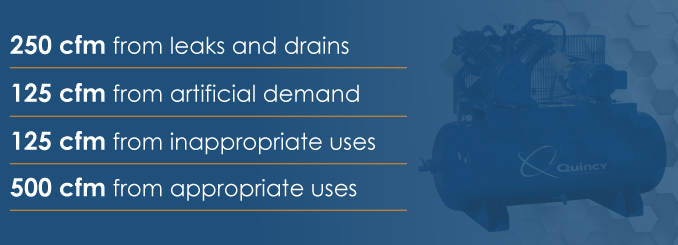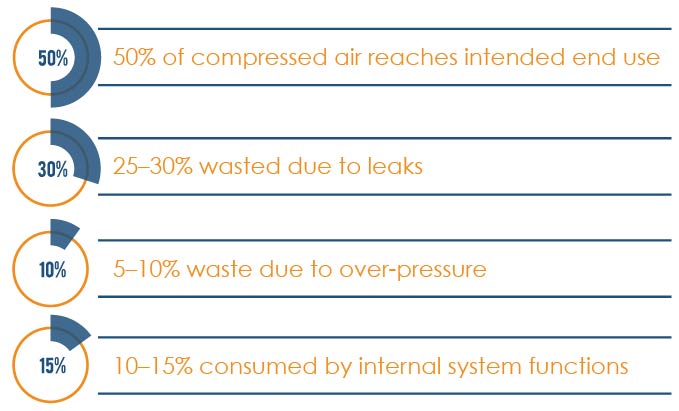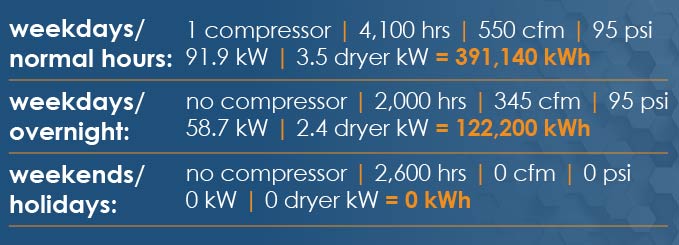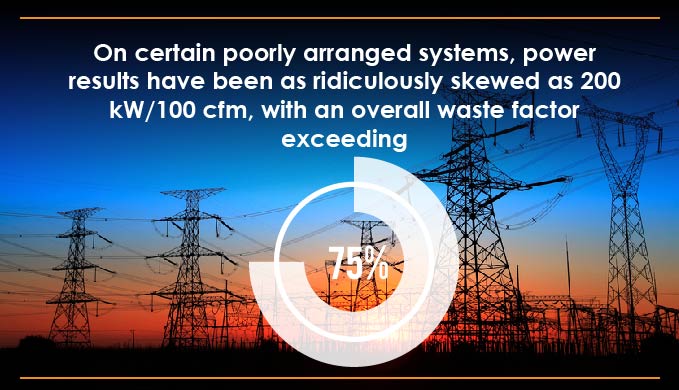Air compressors are generally used for heavy-duty applications that demand optimal performance and utmost power at all times. Over the course of a typical year, the day-to-day grind that a given machine endures can take its toll on more than just the mechanisms and circuitry. For operators, the expenses that accrue from compressed-air systems can account for significant portions of business overhead. Therefore, it’s crucial for systems that utilize compressed air to be run as efficiently as possible with the lowest amount of power or energy waste. All of this begs the question: Is compressed air perfection attainable?
Truth be told, “perfection” is a strong word to be throwing around with regards to the quality of air that emerges from an air compressor. In terms of power-to-production ratio, the performance of an optimally running, sufficiently lubed, rotary-screw air compressor generally goes like this:
Contact Us Learn More Find a Dealer Near You
5 kW power = 100 cfm compressed air @ 100 pi
The air–drying portion of this process is a further 0.5 kW = 100 cfm.
As soon as the compressed air arrives at its end destination, it’s turned into a form of energy that is used to power mechanical equipment. One example of this process in action is the function of a rotary vane air motor, which could be used to power a pneumatic paint mixer in factories, where the air-to-power ratio would go like this:
60 cfm of compressed air = 1 kW at the motor shaft
If one were to go by the terms of the air compressor itself, this would amount to 1.7 kW of motor power for every 100 cfm of air that gets consumed by the compressor during the whole process. In all practicality, however, this amounts to roughly 10.3 kW of input power from the compressor per single kilowatt of output from the air motor. In other words, even without the factors of leaks and pressure differentials, the greatest power efficiency conceivable during the conversion process is just under 10%.
What Happens to the Energy?
A lot of users are surprised by the low-power energy conversion, and thus wonder what actually happens to the rest of the energy. As is readily apparent in any compressor room, however, heat is the primary output of a compressor unit. Therefore, the majority of energy that goes into such machinery is turned into heat. Mathematically, the ratio is explained as follows:
1 bhp = 2,545 btu/hr = 0.746 kW
To take another look at an imperfect yet realistic system, imagine you have the following setup:
- An air compressor system that consists of a trio of 150-hp lubricated screw machines.
- The compressors each use their own refrigerated, filter-equipped air dryers.
- The system is equipped with 1,400 gallons of storage, or two gal. per cfm.
- The compressors run in load/unload mode: 10 psi pressure band per compressor and five psi between each step.
- Two of the compressors run regularly while the third serves as a backup.
- The compressors and dryers have timer-controlled condensate drains.
The conversion efficiency of this system would likely perform as follows during a normal shift at a pressing plant:
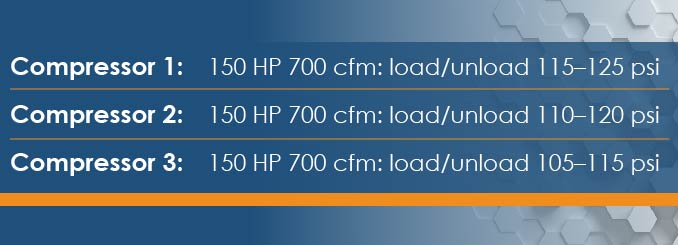
With air from each compressor going through a separate particulate filter, coalescer filter and non–cycling refrigerated air dryer, the results once the post-filtered air from all three tanks is jointly funneled through a 700-gallon dry tank would be as follows:
Efficiency vs. Waste From the Average Compressed Air System
According to information compiled by the Compressed Air Challenge, only half of all compressed air that machines produce at pressing plants is actually put to its intended use. The other half mostly suffers the following fate:
- Between 1/4 and 1/3 of compressed air ends up leaking from the system before it reaches the tip of a pneumatic tool.
- Roughly 1/8 of compressed air is wasted at the tips of tools due to the amount of machine pressure, which can often exceed the amount needed for the application in question.
Remaining amounts of compressed air that seemingly go to waste do so for a reason: The air is used for internal functions of the system itself. An example of internalized usage would be the function of the condensate drains, which partition certain amounts of compressed air for separator-bowl clearance. Additionally, air can get consumed when the compressor is left on idle between applications. The overall usage pie chart roughly divides as follows:
According to research compiled by compressor manufacturers, nearly two-thirds (65%) of industrial systems employ a 24/7 load profile, in which air is compressed at high rates for shifts of 16 hours on weekdays, but slower overnight and on weekends. For a 700 cfm air compressor that consumes 126 kW at 125 psi, the typical schedule over the course of a year results in the following annual power consumption:
- weekdays/normal hours: two compressors | 4,100 hrs | 1,000 cfm | 115 psi | 202.3 kW | 16.2 dryer kW = 895,850 kWh
- weekdays/overnight: one compressor | 2,000 hrs | 530 cfm | 120 psi | 113.0 kW | 16.2 dryer kW = 258,400 kWh
- weekends/holidays: one compressor | 2,660 hrs | 370 cfm | 120 psi | 95.8 kW | 16.2 dryer kW = 297,920 kWh
In total, the annual power consumption is approximately 8,760 hours at 701 cfm and 165.8 kW. At a cost of 10 cents per kWh, this system would amount to $145,220 in annual electrical bills. Given how only half of the compressed air is used as intended, a lot of money admittedly gets consumed not for the end goal of delivering pneumatic power, but for the mere ability to supply such power.
Is Perfection a Realistic Goal?
The question still lingers: Is perfection even reachable with an air compressor? It can certainly be brought within viewing distance, as long as the processes that help procure compressed air are handled with efficiency. In short, the expenses associated with operating an air compressor can be cut in two ways:
- Increased efficiency of air production
- Reductions in levels of air being compressed
In certain quarters, it’s even been suggested that compression heat could be used to bring down operating costs by offsetting the need for heat in other areas.
How to Produce Compressed Air With Greater Efficiency
Depending on how the air compressor and related equipped is operated, efficiency can be increased during the whole process. With the following steps, the goal of higher efficiency and less power consumption can be realized:
- Choose air compressors with lower power specifications.
- Program compressors with reduced run times and lower discharge pressure and reserve the more efficient machines for the busiest times of day.
- Lower the level of compressor discharge to reduce the pressure associated with air-dryer, piping and filter differentials.
- Select pipes, fittings, hoses, connectors and conditioning equipment that offer the least amount of flow-restriction, so as to reduce discharge pressure.
- Select storage receivers with higher capacities, which allow for greater efficiency in running mode and conservation during off hours.
- Choose air-drying components that automatically consume less power during slow operations and shut down completely during off hours.
- Switch off the compressor power when the system is not in use.
- Remove condensate and leakage on a daily basis.
- Apply controls to the plant pressure and flow.
How to Make More Efficient, Less Wasteful Use of Compressed Air
Learning to make more efficient use of an air compressor is only part of what it takes to achieve compressed air perfection — learning how to use less air is also important. There are many different ways to go about this, including:
- Initiating a method for stopping leaks — reduce leaks to five percent of the overall air flow.
- Examining how the compressed air is being used at each level of intensity to determine if the consumption level is proportionate to the needs of the application.
- Halting any application that could be more efficiently performed with electric or hand tools.
- Removing drainage from filter trays on a daily basis.
- Repairing or replacing pneumatic tools or machines that cause pressure levels from the air compressor to catapult to wasteful levels. Set the overall pressure limit to 90 psi.
- Installing shutoff valves so airflow halts at the end of each production shift. Keep airflow sealed off from equipment zones during off hours.
An Example of an Optimized System
With the average compressed air system discussed earlier in this article, efficiency could be improved with some choice adjustments as outlined in the following steps:
- Cut down the wasteful end uses to 25 cfm.
- Reduce system leakage to five percent.
- Optimize main and distribution pipes.
- Reduce plant pressure to 90 psi — this can be achieved with a more discriminate selection of end-supply components.
- Lower compressor discharge to 100 psi. Optimized air dryers and differential filters make this possible.
- Install cycling units with appropriate sizes for each air compressor. This way, the air dryers consume less.
Production-wise, the newly improved compressed-air system would yield roughly the following annual results:
In total, the annual power consumption would be approximately 8,760 hours with a weighted average of 336 cfm and 58.6 kW. As far as electrical costs are concerned, this improved system would trim energy bills down by 65% for an annual savings of $93,830. The system’s precise power would be somewhere around 17.4 kW/100 cfm. With the waste ratio trimmed from 50% to 10%, internalized functions like the air-mixer motor would function at more efficient usage rates.
All of this begs the question: Can such results be achieved by the average industrial facility? The answer is yes, providing that system efficiency is made a top priority among operators of air compressors.
The calculations for both the average and optimized system were determined based on a typical load/unload operation. However, a lot of compressed-air systems utilize setups with even less efficiency, with several extraneous compressors running simultaneously and causing unfavorable power results. On certain poorly arranged systems, power results have been as ridiculously skewed as 200 kW/100 cfm, with an overall waste factor exceeding 75%. When a system produces power figures with that level of inefficiency and waste, there’s indeed room for tremendous improvement that can be achieved as long as the operators are committed to turning those number around.
How Close to Perfection Is Your Compressed-Air System?
Noting the power numbers of the optimized system, you might be curious as to how your system stacks up in terms of efficiency, in which case the first thing to do is have your system assessed. For that, you can utilize instruments that will gauge and calculate your power numbers on an ongoing basis to track the overall pattern and averages. Before you take that step, however, it could be more prudent to have a professional auditor evaluate your compressed-air system for general efficiency. Perfection might seem like pie in the sky, but aiming as high as you can could bring about vast savings and an improved understanding on how to best operate an air compressor.
For some of the most efficient and reliably high-quality air compressors on the market, look no further than Quincy Compressor. As a leading manufacturer of air compressors and pneumatic tools for nearly a century, Quincy has long provided optimal machines to businesses across the industrial sector that demand high performance in their compressed-air operations. Throughout the United States and abroad, our air compressors have saved money and reduced waste in pressing plants, production facilities, repair shops and many other industries that rely on pneumatic power.
If you’re looking to purchase one or more air compressors for heavy-duty applications of any scope or size, make Quincy your go-to source for all things related to pneumatic machines and peripherals. Alternately, if you need to upgrade from an older set of inefficient machines, check out our full range of modern, efficient air compressors. To learn more about our inventory, visit our sales and service locator page right now.


